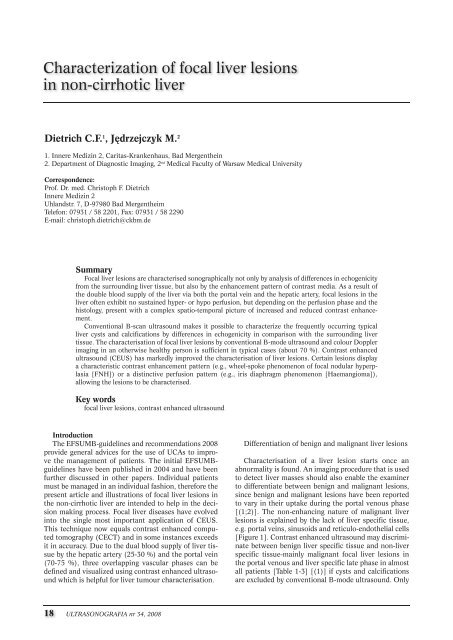in Producing sonoporation, 2007 iEEE Ultrasonics symposium, 424-427 28. tachibana k., Uchida t., ogawa k., Yamashita n., and tamura k., induction of cell membrane porosity by ultrasound, the lancet, 353, pp. 1409, 1999. 29. Mehier-Humbert s., Bettinger t., Yan f., guy R.H., Plasma membrane poration induced by ultrasound exposure: implication for drug delivery, Journal of controlled Release, 104, pp. 213-222, 2005. 30. Mesiwala, a.H., farrell, l., Wenzel, H.J., et al., 2002. High intensity focused ultrasound selectively disrupts the blood brain barrier in vivo. Ultrasound Med. Biol. 28, 389–400. 31. Hynynen, k., McDannold, n., Vykhodtseva, n., Jolesz, f.a., et al., 2001a. noninvasive MR imaging guided opening of the blood brain barrier in rabbits. Radiology 220, 640–646. 32. Hynynen, k., McDannold, n., sheikov, n.a., et al., 2005. local and reversible blood brain barrier disruption by non-invasive focused ultrasound at frequencies suitable for trans-skull sonications. neuroimage 24, 12–20. 33. crowder, k.c., Hughes, M.s., Marsh, J.n., et al., 2005. sonic activation of molecularly targeted nanoparticles accelerates transmembranelipid delivery to cancer cells through contact mediated mechanisms: implications for enhanced local drug delivery. Ultrasound Med. Biol. 31, 1693–1700. 34. Bao, s., thrall, B.D., Miller, D.l., 1997. transfection of reporter plasmid into cultured cells by sonoporation in vitro. Ultrasound Med.Biol. 23, 953– 959. 35. kim, H.J., greenleaf, J.f., kinnick, R.R., Bronk, J.t., 1996. Ultrasound mediated transfection of mammalian cells. Human gene ther. 7, 1339–1346. 36. lawrie, a., Brisken, a.f., francis, s.E., tayler, D.i., chamberlain, D.c., newman, c.M., 1999. Ultrasound enhances reporter gene expression after transfection of vascular cells in vitro. circulation 99, 2617–2620. 37. Bao, s., thrall, B.D., gies, R.a., Miller, D.l., 1998. in vivo transfection of melanoma cells by lithotripter shock waves. cancer Res. 58,219–221. 38. greenleaf, W.J., Bolander, M.E., sarkar, g., goldring, M.B., greenleaf, J.f., 1998. artificial cavitation nuclei significantly enhance acoustically induced cell transfection. Ultrasound Med. Biol. 24, 587–595. 39. lawrie, a., Brisken, a.f., francis, s.E., cumberland, D.c., crossman, D.c., newman, c.M., 2000. Microbubble enhanced ultrasound for vascular gene therapy. gene therapy 7, 2023–2027. Terapeutyczne zastosowanie ultradźwięków 40. Manome, Y., nakamura, M., ohno, t., furuhata, H., 2000. Ultrasound facilitates transduction of naked plasmid Dna into colon carcinoma cells in vitro and in vivo. Hum. gene ther. 11, 1521–1528. 41. tachibana, k., tachibana, s., 1999. application of ultrasound energy as a new drug delivery system. Jpn. J. appl. Phys. 38, 3014–3019. 42. feril l., ogawa R., kondo t., tachibana k., ogawa k., irie Y., optimized ultrasound-mediated gene transfection: a better alternative to other nonviral methods, Ultrasound in Medicine & Biology, 32, 5, 170, 2006a, 43. feril, l. B.; ogawa R., tachibana k., takashi k., optimized ultrasound-mediated gene transfection in cancer cells , Cancer Science, 97, 10, pp. 1111-1114, 2006b 44. nozaki t., ogawa R., Watanabe a., nishio R., fuse H., kondo t., Ultrasound-mediated gene transfection: problems to be solved and future possibilities, J Med Ultrason, 33;3;pp.135-142, 2006 45. nozaki t., ogawa R,. feril l., kagiya g., fuse H, kondo t, Enhancement of ultrasound-mediated gene transfection by membrane modification the Journal of gene Medicine, 5,12, pp.1046 – 1055, 2008 46. Rosenschein, U., Roth, a., Rassin, t., et al., 1997. analysis of coronary ultrasound thrombolysis endpoints in acute myocardial infarctions. am. J. cardiol. 80, 1411–1416. 47. Yock, P.g., fitzgerald, P.J., 1997. catheter based ultrasound thrombolysis. circulation 95, 1360–1362. 48. Roy, R., Madanshetty, s.i., apfel, R.E., 1990. an acoustic back-scattering technique for the detection of transient cavitation produced by microsecond pulses of ultrasound. J. acoust. soc. am. 87, 2451–2458. 49. ter Haar, g.R., 1995. Ultrasound focal beam surgery. Ultrasound Med. Biol. 21, 1089–1100. 50. Baker k.g., Robertson V.J., Duck f.a., a Review of therapeutic Ultrasound: Biophysical Effects, Physical therapy, 81, 7, 1351-1358, 2001, 555 51. Madersbacher, s., schatzl, g., Djavan, R., stuling, t., Marberger, M., 2000. long-term outcome of transrectal high-intensity focused ultrasound therapy for benign prostatic hyperplasia. Eur. Urol. 37, 687–694. 52. Delon-Martin, c., Vogt, c., chignier, E., guers, c., chapelon, J.Y., cathignol, D., 1995. Venous thrombosis generation by means of high intensity focused ultrasound. Ultrasound Med. Biol. 21, 113–119. 53. Vaezy, s., Martin, R., schmiedl, U., et al., 1997. liver haemostasis using high intensity focused ultrasound. Ultrasound Med. Biol. 23, 1413–1420. ULTRASONOGRAFIA nr 34, 2008 17
Characterization of focal liver lesions in non-cirrhotic liver Dietrich C.F. 1 , Jędrzejczyk M. 2 1. innere Medizin 2, caritas-krankenhaus, Bad Mergenthein 2. Department of Diagnostic imaging, 2 nd Medical faculty of Warsaw Medical University Correspondence: Prof. Dr. med. christoph f. Dietrich innere Medizin 2 Uhlandstr. 7, D-97980 Bad Mergentheim telefon: 07931 / 58 2201, fax: 07931 / 58 2290 E-mail: christoph.dietrich@ckbm.de Summary focal liver lesions are characterised sonographically not only by analysis of differences in echogenicity from the surrounding liver tissue, but also by the enhancement pattern of contrast media. as a result of the double blood supply of the liver via both the portal vein and the hepatic artery, focal lesions in the liver often exhibit no sustained hyper- or hypo perfusion, but depending on the perfusion phase and the histology, present with a complex spatio-temporal picture of increased and reduced contrast enhancement. conventional B-scan ultrasound makes it possible to characterize the frequently occurring typical liver cysts and calcifications by differences in echogenicity in comparison with the surrounding liver tissue. the characterisation of focal liver lesions by conventional B-mode ultrasound and colour Doppler imaging in an otherwise healthy person is sufficient in typical cases (about 70 %). contrast enhanced ultrasound (cEUs) has markedly improved the characterisation of liver lesions. certain lesions display a characteristic contrast enhancement pattern (e.g., wheel-spoke phenomenon of focal nodular hyperplasia [fnH]) or a distinctive perfusion pattern (e.g., iris diaphragm phenomenon [Haemangioma]), allowing the lesions to be characterised. Key words focal liver lesions, contrast enhanced ultrasound Introduction the EfsUMB-guidelines and recommendations 2008 provide general advices for the use of Ucas to improve the management of patients. the initial EfsUMBguidelines have been published in 2004 and have been further discussed in other papers. individual patients must be managed in an individual fashion, therefore the present article and illustrations of focal liver lesions in the non-cirrhotic liver are intended to help in the decision making process. focal liver diseases have evolved into the single most important application of cEUs. this technique now equals contrast enhanced computed tomography (cEct) and in some instances exceeds it in accuracy. Due to the dual blood supply of liver tissue by the hepatic artery (25-30 %) and the portal vein (70-75 %), three overlapping vascular phases can be defined and visualized using contrast enhanced ultrasound which is helpful for liver tumour characterisation. 18 ULTRASONOGRAFIA nr 34, 2008 Differentiation of benign and malignant liver lesions Characterisation of a liver lesion starts once an abnormality is found. an imaging procedure that is used to detect liver masses should also enable the examiner to differentiate between benign and malignant lesions, since benign and malignant lesions have been reported to vary in their uptake during the portal venous phase [(1;2)]. the non-enhancing nature of malignant liver lesions is explained by the lack of liver specific tissue, e.g. portal veins, sinusoids and reticulo-endothelial cells [figure 1]. contrast enhanced ultrasound may discriminate between benign liver specific tissue and non-liver specific tissue-mainly malignant focal liver lesions in the portal venous and liver specific late phase in almost all patients [table 1-3] [(1)] if cysts and calcifications are excluded by conventional B-mode ultrasound. only
- Page 1 and 2: ISSN 1429-7930 Vol. 8, 34, 2008 KWA
- Page 3 and 4: Ultrasonografia jest pismem Polskie
- Page 5 and 6: spis treści UltRasonogRafia nR 34
- Page 7 and 8: Content list ULTRASONOGRAPHY 34 Edi
- Page 9 and 10: 8 ULTRASONOGRAFIA nr 34, 2008
- Page 11 and 12: 1. Wprowadzenie Efekty termiczne -
- Page 13 and 14: Rys. 2. Przebieg impulsu ciśnienia
- Page 15 and 16: tis jak i modelu kości blisko poł
- Page 17: 7. Podsumowanie Podsumowując ten j
- Page 21 and 22: More specific liver tumour characte
- Page 23 and 24: shunt haemangiomas are typically su
- Page 25 and 26: 24 ULTRASONOGRAFIA nr 34, 2008 Diet
- Page 27 and 28: 7. von Herbay a, Vogt c, Haussinger
- Page 29 and 30: Andrzej Lewicki, Maciej Jędrzejczy
- Page 31 and 32: Andrzej Lewicki, Maciej Jędrzejczy
- Page 33 and 34: Andrzej Lewicki, Maciej Jędrzejczy
- Page 35 and 36: Andrzej Lewicki, Maciej Jędrzejczy
- Page 37 and 38: Andrzej Lewicki, Maciej Jędrzejczy
- Page 39 and 40: Ultrasonograficzny środek kontrast
- Page 41 and 42: Magdalena M. Woźniak, Rafał Kryza
- Page 43 and 44: Magdalena M. Woźniak, Rafał Kryza
- Page 45 and 46: Magdalena M. Woźniak, Rafał Kryza
- Page 47 and 48: 46 ULTRASONOGRAFIA nr 34, 2008 E. D
- Page 49 and 50: 48 ULTRASONOGRAFIA nr 34, 2008 E. D
- Page 51 and 52: 50 ULTRASONOGRAFIA nr 34, 2008 E. D
- Page 53 and 54: 52 ULTRASONOGRAFIA nr 34, 2008 Maci
- Page 55 and 56: 54 ULTRASONOGRAFIA nr 34, 2008 Maci
- Page 57 and 58: 56 ULTRASONOGRAFIA nr 34, 2008 Maci
- Page 59 and 60: 58 ULTRASONOGRAFIA nr 34, 2008 Maci
- Page 61 and 62: Piśmiennictwo: 1. lumsden a, Mille
- Page 63 and 64: Andrzej Smereczyński, Teresa Starz
- Page 65 and 66: Andrzej Smereczyński, Teresa Starz
- Page 67 and 68: zastosowanie ultrasonograficznych
- Page 69 and 70:
Anna Drelich-Zbroja, Monika Miazga,
- Page 71 and 72:
Piśmiennictwo: Anna Drelich-Zbroja
- Page 73 and 74:
zastosowanie ultrasonograficznych
- Page 75 and 76:
gastroenterol. 2006; 101:45-51. 7.
- Page 77 and 78:
tylko w 5-6%. W raku koloidowym mie
- Page 79 and 80:
Rodzaje prenatalnych badań ultraso
- Page 81 and 82:
w roku 2007 pisanie odręcznych wyn
- Page 83 and 84:
82 ULTRASONOGRAFIA nr 34, 2008 Mari
- Page 85 and 86:
84 ULTRASONOGRAFIA nr 34, 2008 Mari
- Page 87 and 88:
Piśmiennictwo: 1. aleszewicz-Baran
- Page 89 and 90:
Dzięki rozwojowi technik obrazowan
- Page 91 and 92:
Ryc. 1. Poszerzone tętnice wieńco
- Page 93 and 94:
opis przypadku kobieta M.P. lat 75
- Page 95 and 96:
Piśmiennictwo: 1. Jakubowski W. Di
- Page 97 and 98:
Ryc. 1. Sutek lewy godz. 13.00 pods
- Page 99 and 100:
Zalecenia Polskiego Towarzystwa Ult
- Page 101 and 102:
sprawozdanie z konferencji internat
- Page 103 and 104:
zagadka ultrasonograficzna 39-letni
- Page 105 and 106:
list do Redakcji Szanowny Panie Red
- Page 107 and 108:
odpowiedź na zagadkę ultrasonogra
- Page 109:
wej nie mo że prze kra czać 12 st



![Ultrasonografia nr21 [4.58 Mb] - Kwartalnik](https://img.yumpu.com/51838921/1/184x260/ultrasonografia-nr21-458-mb-kwartalnik.jpg?quality=85)
![Ultrasonografia nr35 [13.00 MB] - Kwartalnik](https://img.yumpu.com/10640460/1/188x260/ultrasonografia-nr35-1300-mb-kwartalnik.jpg?quality=85)
![Ultrasonografia nr39 [8.00 MB] - Kwartalnik](https://img.yumpu.com/10637726/1/188x260/ultrasonografia-nr39-800-mb-kwartalnik.jpg?quality=85)

![Ultrasonografia nr46 [3.17 Mb] - Kwartalnik](https://img.yumpu.com/6154909/1/188x260/ultrasonografia-nr46-317-mb-kwartalnik.jpg?quality=85)